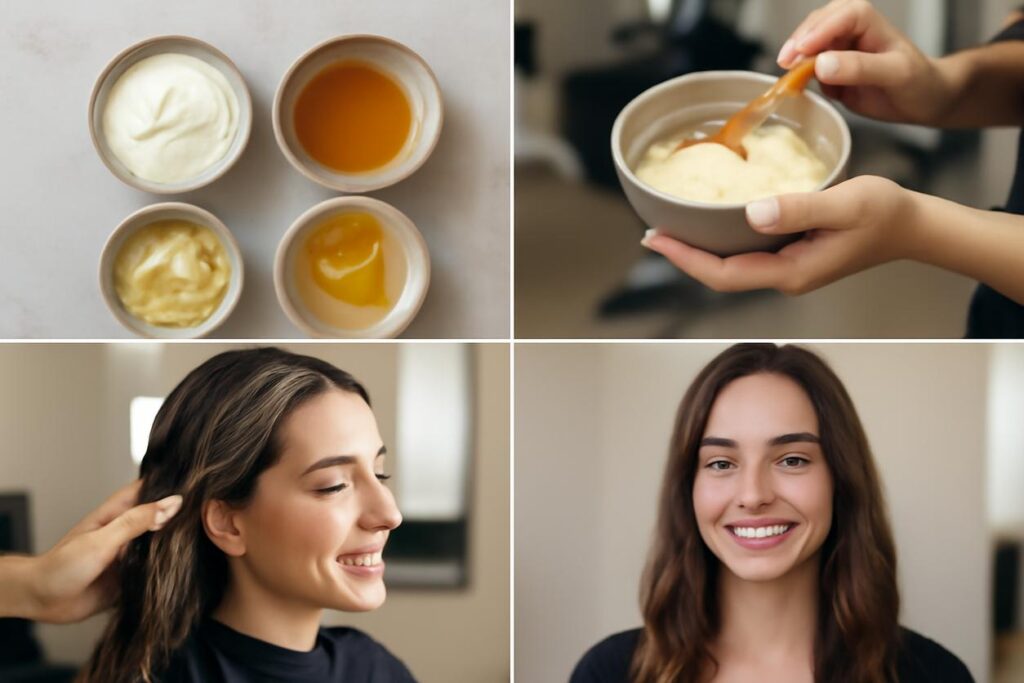Your Ultimate Guide to Home Remedies for Hair Growth in 2025
Table of Contents
- Introduction: Unlocking Natural Hair Growth at Home
- Hair Growth in Plain Terms: How Follicles Work
- Assessing Your Hair and Scalp: Simple Self-Checks
- Five Kitchen-Based Remedies and The Science Behind Them
- Preparation and Safety: Patch Tests and Allergy Notes
- Recipe 1: Nourishing Oil Scalp Massage
- Recipe 2: Protein Boost Mask with Egg and Yogurt
- Recipe 3: Hydrating Aloe and Honey Treatment
- Recipe 4: Allium Extract (Onion) Juice for the Scalp
- Recipe 5: Herbal Rinses and Plant Infusions
- How to Build a Weekly At-Home Routine
- Daily Habits That Support Stronger Hair
- When to Pause Home Remedies and Seek Medical Input
- Troubleshooting: Why You Might Not See Change
- Copyable Weekly Care Plan and Checklist
- References and Further Reading
Introduction: Unlocking Natural Hair Growth at Home
Have you noticed your hair growing slower than it used to, or perhaps appearing a bit thinner? You’re not alone. Many people seek ways to support their hair’s natural vitality. This guide is for those who are curious about effective, natural solutions and want to explore home remedies for hair growth. We’ll skip the complex jargon and focus on practical, kitchen-based recipes that you can try today.
This comprehensive guide provides you with actionable steps, from understanding how your hair grows to creating a personalized weekly care routine. We will explore five simple yet powerful treatments, explain the reasoning behind them, and detail how to prepare them safely. Consider this your starting point for a more natural approach to hair care in 2025 and beyond.
Hair Growth in Plain Terms: How Follicles Work
Before diving into remedies, it helps to understand the basics. Every single hair on your head grows from a tiny pocket in your skin called a hair follicle. Hair growth happens in a cycle with three main phases:
- Anagen (The Growing Phase): This is the active phase where hair is physically growing. It can last anywhere from 2 to 7 years. The length of this phase determines the maximum length of your hair.
- Catagen (The Transition Phase): A short, transitional phase lasting a few weeks. The hair follicle shrinks, and growth slows down.
- Telogen (The Resting Phase): The follicle is dormant for about 3 months before the hair sheds and the cycle begins anew with a fresh strand.
When we talk about supporting hair growth, we are essentially trying to create the best possible environment for the follicles to remain in the anagen phase longer and produce strong, healthy hair strands. Effective home remedies for hair growth often focus on improving scalp circulation, providing key nutrients, and reducing damage.
Assessing Your Hair and Scalp: Simple Self-Checks
Understanding your starting point is key. Take a moment to assess your hair and scalp. This will help you choose the remedies best suited for you.
- Check Your Scalp: Is it oily, dry, or flaky? An oily scalp might benefit from clarifying treatments like herbal rinses, while a dry scalp may need the deep moisture of an oil massage.
- Examine Your Hair Strands: Gently stretch a single strand of hair. If it snaps easily, it may lack protein. If it feels mushy or overly stretchy, it might have too much moisture and need a protein boost. If it feels rough and dry, it’s likely thirsty for hydration.
- Note Your Shedding: It’s normal to lose 50-100 hairs a day. If you notice a sudden, significant increase in shedding on your brush or in the shower, it’s worth paying closer attention.
Five Kitchen-Based Remedies and The Science Behind Them
The best home remedies for hair growth are often made from simple ingredients you already have. These treatments work by nourishing the scalp, strengthening the hair shaft, and creating an optimal environment for follicles to thrive. We will focus on recipes that are easy to prepare and backed by logical principles of hair biology.
Preparation and Safety: Patch Tests and Allergy Notes
Important: Before applying any new substance to your entire scalp, always perform a patch test. Apply a small amount of the mixture to a discreet area of skin, like behind your ear or on your inner elbow. Wait 24 hours to see if any irritation, redness, or itching occurs. If it does, do not use the remedy. This is especially crucial for those with sensitive skin or known allergies.
Recipe 1: Nourishing Oil Scalp Massage
A scalp massage is a cornerstone of natural hair care. The physical act of massaging stimulates blood flow to the scalp, which helps deliver more oxygen and nutrients to your hair follicles.
Why It May Help
Increased circulation can invigorate dormant follicles and support a healthy growth phase. Using a carrier oil like coconut or jojoba oil provides additional benefits, such as moisturizing the scalp, reducing flakiness, and adding fatty acids that can penetrate the hair shaft to reduce protein loss.
How to Do It: Step-by-Step
- Choose Your Oil:
- Coconut Oil: Great for penetrating the hair shaft and preventing protein loss. Best for normal to dry hair types.
- Jojoba Oil: Its molecular structure is very similar to our skin’s natural sebum, making it a fantastic moisturizer for all hair types.
- Olive Oil: A heavier oil, excellent for very dry or damaged hair.
- Warm the Oil: Gently warm 2-3 tablespoons of your chosen oil. It should be comfortably warm, not hot.
- Apply to Scalp: Part your hair into sections and use your fingertips to apply the warm oil directly to your scalp.
- Massage Gently: Using the pads of your fingers (not your nails), massage your entire scalp in small, circular motions for 5-10 minutes. Apply gentle but firm pressure.
- Let It Sit: Leave the oil on for at least 30 minutes, or overnight for a deep conditioning treatment. You can wrap your hair in a warm towel to enhance absorption.
- Wash Out: Shampoo and condition your hair as usual. You may need to shampoo twice to remove all the oil.
Recipe 2: Protein Boost Mask with Egg and Yogurt
Hair is primarily made of a protein called keratin. A protein mask can help temporarily patch weak spots in the hair cuticle, adding strength and reducing breakage.
Why It May Help
Eggs are a rich source of protein and biotin, two nutrients essential for hair health. Plain yogurt contains lactic acid, which helps to cleanse the scalp, and probiotics, which may support a healthy scalp microbiome. This combination can fortify brittle strands.
How to Do It: Step-by-Step
- Gather Ingredients: You will need 1 egg and 2 tablespoons of plain, unsweetened yogurt.
- Mix Well: Whisk the egg and yogurt together in a bowl until you have a smooth, consistent paste.
- Apply to Hair: Apply the mask to damp hair, starting from the roots and working your way down to the tips. Ensure all strands are covered.
- Wait: Let the mask sit for 20-30 minutes. Do not leave it on for too long, as protein overload can make hair feel stiff.
- Rinse with Cool Water: It is crucial to rinse with cool or lukewarm water. Hot water can cook the egg in your hair, making it very difficult to remove.
- Shampoo and Condition: Follow up with your regular washing routine.
Recipe 3: Hydrating Aloe and Honey Treatment
If your hair is dry and your scalp is irritated, this soothing and hydrating mask is an excellent choice. It focuses on moisture rather than protein.
Why It May Help
Aloe vera contains proteolytic enzymes that can help repair dead skin cells on the scalp. It is also a great conditioner, leaving hair smooth and shiny. Honey is a natural humectant, meaning it attracts and seals moisture into your hair.
How to Do It: Step-by-Step
- Gather Ingredients: You will need 2 tablespoons of pure aloe vera gel (from a leaf is best) and 1 tablespoon of raw honey.
- Create the Mixture: Mix the aloe vera and honey together until they form a smooth gel.
- Apply to Scalp and Hair: Apply the mixture primarily to your scalp and then work it through the lengths of your hair.
- Let It Penetrate: Leave the treatment on for 30 minutes. You can use a shower cap to contain the mixture and trap heat.
- Rinse Thoroughly: Rinse out with lukewarm water, followed by your regular shampoo and conditioner.
Recipe 4: Allium Extract (Onion) Juice for the Scalp
While the smell is potent, onion juice is a traditional home remedy for hair growth. Its potential benefits are linked to its high sulfur content.
Why It May Help
Sulfur is a building block for keratin. Some preliminary research suggests that the topical application of onion juice might help stimulate follicles, possibly by providing the scalp with extra sulfur or through its antioxidant properties. However, more robust studies are needed.
How to Do It and Precautions
- Preparation: Peel and chop one small onion. Blend it into a pulp and then strain the juice through a cheesecloth or fine sieve.
- Application: Using a cotton ball, dab the onion juice directly onto your scalp. Focus on the roots.
- Wait (Briefly): Leave the juice on for 15-30 minutes. Do not leave it on for longer, as it can be irritating.
- Wash Thoroughly: Wash your hair very well with shampoo to remove the juice and minimize the odor.
- Precautions: Onion juice is very potent. Absolutely perform a patch test first. Avoid this remedy if you have a sensitive scalp. The smell is strong and can linger.
Recipe 5: Herbal Rinses and Plant Infusions
An herbal rinse is a simple, final step after conditioning that can benefit the scalp and add shine to your hair.
Why It May Help
Different herbs offer different benefits. Rosemary is thought to stimulate circulation in the scalp, similar to a massage. Green tea is rich in antioxidants that can help protect follicles from free radical damage. These rinses can help clarify the scalp without stripping natural oils.
How to Do It: Easy Blends
- Brew the Infusion: Add a tablespoon of dried rosemary or one green tea bag to a cup of hot water. Let it steep for at least 15-20 minutes, then allow it to cool completely.
- Apply as a Final Rinse: After shampooing and conditioning, slowly pour the cooled herbal infusion over your scalp and hair.
- Massage and Leave In: Gently massage your scalp for a minute. There is no need to rinse it out. Simply towel-dry and style your hair as usual.
How to Build a Weekly At-Home Routine
Consistency is more important than intensity when using home remedies for hair growth. Over-treating your hair can cause more harm than good. Here is a sample routine:
- Once a week: Perform a nourishing oil scalp massage. This is a great foundation for any hair care routine.
- Every two weeks: Alternate between a protein mask and a hydrating mask, depending on what your hair needs. If your hair feels brittle, use the protein mask. If it feels dry, use the hydrating one.
- Once or twice a week: Use an herbal rinse as the final step in your wash routine.
Daily Habits That Support Stronger Hair
Topical treatments work best when supported by a healthy lifestyle. Your daily habits play a huge role in hair health.
- Diet: Eat a balanced diet rich in protein (eggs, legumes), iron (spinach, lentils), zinc (nuts, seeds), and vitamins like biotin and vitamin C (berries, citrus fruits).
- Sleep: Aim for 7-9 hours of quality sleep per night. This is when your body’s cells, including those in your hair follicles, repair and regenerate.
- Gentle Handling: Avoid tight hairstyles that pull on the follicles. Use a wide-tooth comb on wet hair, and minimize high-heat styling tools.
- Stress Management: Chronic stress can disrupt the hair growth cycle. Incorporate stress-reducing activities like walking, yoga, or meditation into your day.
When to Pause Home Remedies and Seek Medical Input
Home remedies are supportive but cannot treat underlying medical conditions. You should consult a doctor or dermatologist if you experience:
- Sudden or patchy hair loss.
- Hair loss accompanied by scalp itching, pain, redness, or sores.
- A significant and persistent increase in daily shedding.
- Hair loss that occurs after starting a new medication.
These can be signs of conditions that require a professional diagnosis. The NHS provides a helpful overview of hair loss causes that may require medical attention.
Troubleshooting: Why You Might Not See Change
Patience is key. Hair grows slowly—about half an inch per month on average. It can take 3-6 months of consistent use to notice any difference. If you’re not seeing results, consider these points:
- Consistency: Are you sticking to a regular routine? Using a mask once won’t produce lasting results.
- Underlying Issues: Could a nutritional deficiency, hormonal change, or stress be the primary cause? Home remedies can’t fix an internal issue.
- The Right Remedy: Are you using the right treatment for your hair type? Protein-sensitive hair, for instance, won’t react well to frequent egg masks.
Adjust your routine, focus on healthy daily habits, and give it time. Exploring different home remedies for hair growth is about finding what works uniquely for you.
Copyable Weekly Care Plan and Checklist
Use this simple text plan to build your routine. Adjust based on your hair’s needs.
Weekly Hair Care Checklist:
- [ ] Sunday: Nourishing Oil Scalp Massage (leave on 1-2 hours before washing).
- [ ] Monday: Rest day. Gentle combing.
- [ ] Tuesday: Rest day.
- [ ] Wednesday: Co-wash or regular wash day. Follow with a Green Tea or Rosemary Rinse.
- [ ] Thursday: Rest day.
- [ ] Friday: Alternate week treatment – either Protein Mask OR Hydrating Mask.
- [ ] Saturday: Rest day.
Daily Checklist:
- [ ] Eat a balanced meal with protein and vegetables.
- [ ] Drink enough water.
- [ ] Handle hair gently (no tight ponytails).
- [ ] Manage stress with a short walk or deep breathing.
References and Further Reading
For those interested in the science behind hair growth and potential treatments, these resources offer a wealth of information:
- PubMed: A comprehensive database of biomedical literature where you can find scientific studies. You can start by searching for hair growth research.
- DermNet: An excellent resource for dermatological information, including a detailed overview of hair and its conditions.
- NHS (National Health Service, UK): Provides reliable, easy-to-understand medical information, including a page dedicated to hair loss.





